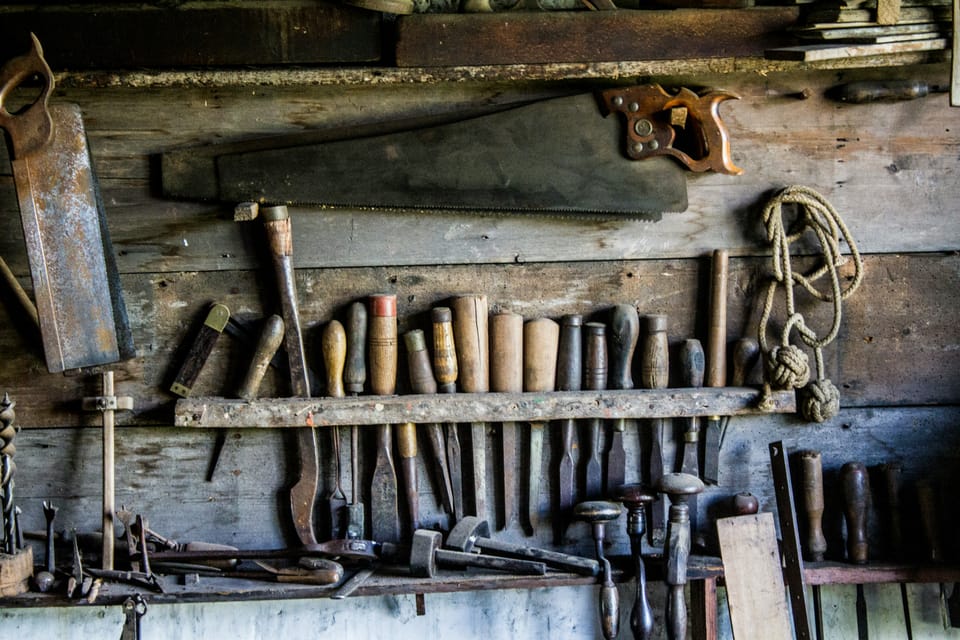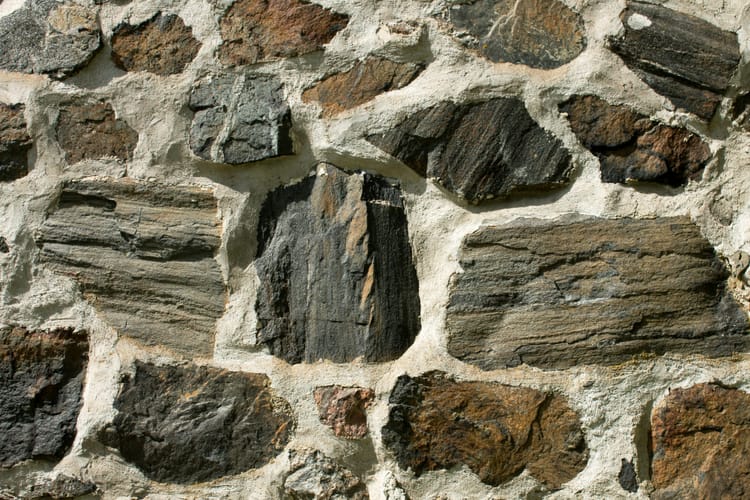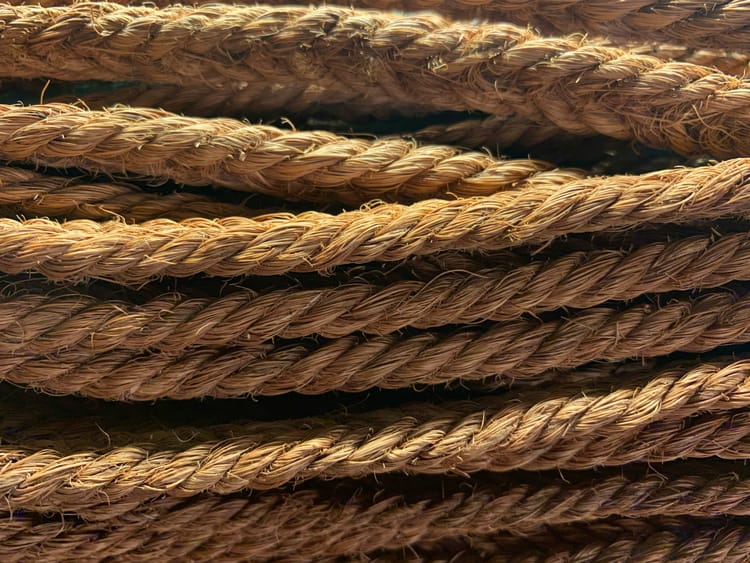First Quarter: Hail to the woodworkers

Hello. It's Friday, and the season is starting to shift in subtle but numerous ways. This land's annual cicadas have begun to sing, and the local farms' peach harvest is underway, and our tomatoes and cucumber are ripe, and our peas have died off. Soon we will plant carrots and squash. Dragonflies and butterflies are everywhere. Blue jays have begun to scream again in the morning, on days when the air pressure is rising.[1] The Corona Borealis is no longer visible all night. Orion meanwhile is just barely visible again. In this house, we've turned on our morning light timer as it's now a little too dim indoors to comfortably wake up as early as we do.
With that brief prologue, this is my third praise-post for artisans, following what I've written for leatherworkers and smiths, other keepers of the old rite of putting-oneself-into-thing. As usual, I am about to enter the dubious territory of discussing skills I have not personally cultivated, but I do not seek to teach, only to offer bardic admiration for those who do have this know-how. At most, for the sake of the time-to-come I hope my words might inspire someone to start learning these skills elsewhere, or perhaps I will eventually talk myself into learning as well.
Bonded to wood
Before we were human, we lived among trees. A tree was life. For a time many of us would also come to seek shelter in caves, but as we took up tools, it was perhaps inevitable that we would learn to work wood as well as stone — and that we would still live in the embrace of refashioned trees, even if we no longer slept in their living boughs. Of course, in order to work a tree's wood for making a home, or furniture, or tools that themselves are wooden, this involves death. Either an entire tree must be dead, or part of it is.
In many traditional land-connected cultures, there is some manner of prohibition against taking living wood straight from the source; wood should be collected where it has already fallen, except in utmost need. And even where this rule does not exist, there are storytelling mechanisms by which people are reminded not to harvest wood wantonly. Think of wood nymphs, and the spirits who inhabit various tree species, such as Lady Elder, who in a number of European folk traditions must be asked permission before collecting her wood (or sometimes even her berries) lest horrendously bad luck befall whoever was so foolish as to bypass the elder's consent.
Perhaps it is for this reason that there are nearly as many myths about particular trees as there are uses for wood. To become a carpenter or any other woodworker means learning what wood suits what purpose, and in ancient times the surrounding mnemonic lore would have grown and grown and grown. Whether they know it or not, those people today who work wood are the guardians of a vast, primeval knowledge base, an interceding priesthood between the flesh of the forest and the dreams of humanity. Though I am no Christian, if there is a directly animist way to view the mythic figure of Jesus Christ one might well argue it's in his role as Yehoshua ben Yosef, the carpenter's son who plies his father's trade while also building a spiritual abode of communion and sanctuary. He who brings a tree's shelter to the shelterless.
But we do not absolutely need that framework[2] to know that woodworking is holy, and to give thanks to those who continue to take up the trade.
Carpentry across space & time
Carpentry is difficult to define, but it encompasses at least all forms of woodworking that go into constructing buildings or ships — or any plausible structure with wooden bones if not also a wooden skin, including sets for theatre and film. Beyond this, I know some people would also add artisans who build functional objects out of wood: the cooper, who makes barrels; the luthier, who makes musical instruments like violins and guitars; the joiner, who makes furniture, cabinets, parquet flooring, and more.
With the advent of industrial technology, some skills that carpenters might have once needed to learn are now "less important" insofar as a manufacturing plant can prepare wood in certain ways through automated machinery. Likewise, making various structures or items with wood has increasingly fallen out of favor compared to other materials like concrete or plastic — and sometimes this change is not a bad thing[3] because of situations where wood's tendency to decompose creates serious problems. However, there are still innumerable contexts in which carpentry of some kind supports basic life necessities and niceties alike, especially in less-industrialized societies. Carpentry is not obsolete yet, not by any stretch of the imagination; and crucially, because of carpentry's timeless value it's worthwhile for any community to foster carpentry skills among some of the populace for whenever more modern infrastructure collapses, either on a short-term disaster basis or on a longer-term basis like we will probably encounter across the globe before the end of this century.
To proliferate and maintain carpentry over so many spatial applications, and to pass it down from older to younger generations, this has required and will continue to require very careful teaching. The other ancient crafts I've written about do sometimes continue to be taught by masters to apprentices, with the journeyman (of any gender) a step in between, but I think it's accurate to say that in "the West" carpentry has preserved this model from the old medieval and post-medieval guilds particularly well. For one thing, carpenters are more unionized; in the United States, the largest union memberships (500,000+ people) for manual trades generally cover post-industrialization jobs, but the UBC still ranks among them. Obviously other pre-industrial manual trades have unions as well, but only a few in such numbers, and they aren't in hand crafts. Smiths, masons, glaziers, cermaic workers, and similar craftspeople do have union representation, but less, both by raw numbers and by percentage; leatherworkers have virtually no union representation at the moment. Meanwhile the percentage of carpenters who are union lies within the top 15 unionization rates for 2022.[4]
I hope that union- or guild-like knowledge preservation among carpenters will continue, for like virtually all manual labor carpentry has always had its dangers, and these have increased with some of the electrical, pneumatic, hydraulic, or steam and gas powered equipment now available. And unlike some (though not all) old hand crafts, in carpentry the final product of one's labor must have intrinsic safety considerations built into it for whoever will be using it. A house must stay upright, a ship must avoid leaking, a chair must hold weight, and so on. I am only an observer, but it strikes me that the humility benefiting all craftspeople plays an especially key part in carpentry — and this seems fitting. For again, this is work with trees, and just as no one would wish to show hubris before the living tree's spirit, neither should that hubris be carried over to any other part of the woodworking process.
Lovespoons & other artworks
The above notwithstanding, I know that humans do not only work wood for architectural functions or to facilitate other activities. Wood can be carved and manipulated for the sake of beauty, not even just making a functional object beautiful but also making pure art. Or perhaps the item still serves a purpose, but that purpose is as-itself: for instance a ritual object, or an impractically small model of something much bigger.
This is how I know woodworking within my own family, because to my knowledge I am not descended from carpenters but I did grow up knowing one guardian of an old Cymric wood art. The guardian was my mam-gu, and the art was lovespoons. I never got to watch her actively carve them, but I did see many of the results.
If you don't know what a lovespoon is, the best I can explain is: though not exclusive to Cymru, it's a culturally specific style of decorative spoon that almost always cannot be (and is not) used to eat anything. Far too impractical. What makes the artwork a spoon is that at the far end there's always a spoon-like bowl, but the "handle" is carved into a sequence of other shapes chosen symbolically by the woodworker, and so it isn't ergonomic for holding. Going as far back as at least a couple centuries, a lovespoon was once a courtship gift offered to a prospective bride by a prospective groom, who was expected to whittle and finish the spoon himself. Consequently, the most traditional symbols to carve into the handle are often of a romantic or domestic nature: heart shapes, wedding bells, locks (for security), caged balls (numbered for how many children are desired). Dense, close-grained hardwoods are favored. These days, people make and collect the spoons more as commercial items, and the array of possible symbols has expanded.
I have been fascinated by lovespoons for as long as I've known about them, and knowing my mam-gu's woodcarving practice I suppose that — as with other crafts she knew — I always like to hear about it from other people who create similar art. I've started to feel as if even long after my mam-gu's death, this craft is increasingly on my periphery. My friend from university who's a fellow hedge witch carves various small items, including the birch wand on my altar; my owner has yet to try his hand extensively, but he bought a set of tools a while ago, and he's at least gotten started by elaborately carving Halloween pumpkins; since then I've been immersed in Tyson Yunkaporta's philosophy, which comes out through his woodworking as much as (or as he might say, even more than) through his writing[5]; and recently I befriended a woodworker who's maybe reading this post and who extremely generously gifted me with a decorative spoon (not a lovespoon, but still symbolic).
I could not tell you where to really draw the line between woodworking as a decorative craft and woodworking as a practical one. There is considerable overlap. Maybe the latter is what carpentry strictly encompasses — crafting objects that inherently need some amount of mathematical engineering principles to factor into their design. But maybe that's not quite it either. In the end, I won't split hairs here; any and all woodworking is magnificent, important, and integral to human existence.
A call to myself
More than the crafting odes I've written so far, I want to take this opportunity to ask myself if my recognition of a woodworker's talent also points to wood calling me to work it.
If so, I'm uncertain how strong a call it is; the constraints of my working life already form enough of an obstacle to recovering hobbies I used to practice in the past. I may be a polymath, but I'm not a hobby collector; I have to prioritize certain things. Outside (and even during) my paid job I have my hands entirely full with writing, occasionally indulging a few other artistic interests, building kink community and practicing kink in general, struggling to co-manage the land we live on, struggling to take care of my health, and my share of domestic duties. Adding on knitting has only worked out because of how easy it is to do when I've already set aside time to relax with a movie.
I also know I would surely make for a skittish carpenter. I learned a little of the very basics in eighth grade shop class, but anything larger than the handheld power tools was fairly terrifying. Much like sewing machines, I have this irrational reservation about getting too close to any contraption where I have to actually move my hands near the component that could maim me (unlike a drill or weed whacker, where protective equipment is still common sense but you generally need to direct the dangerous bits wholly away from yourself). I say this concern is irrational because I have decent focus and proprioception, so I could realistically learn to use something like a table saw quite safely and never have an accident unless bad luck befell — and yet my autism doesn't trust this. Worst of all, as I learned in both shop class and physics classes, I may know how to engineer something that should hold together, but that's an entirely different matter from having the kinesthetic knack for physically assembling that thing in a way where it will hold together.
But despite these limitations, I think woodworking is a practice I need to keep my eye on. My mam-gu's handheld, machinery-free carving could serve as a guide — not only for what I felt I could safely work on, but also for what I had time for. I don't imagine it's wise to whittle in one's lap like knitting, even with a box to catch the mess; however, smaller objects feel less ambitious to me, even if that's not strictly accurate. If I found myself with a lapse in existing projects, maybe I would find some wood for myself and try to intuit what it wanted to become.
It's that intuitive, relational aspect that draws me. I am already ritually invested in the lore of trees, and I think something that would bring me closer to a fuller understanding would be to try working different kinds of wood myself — perhaps not even working so much as playing with.
We will see what the years bring. Right now my craft loyalty has to stay with fiber, but as little time as I have, that could always change. Meanwhile, I offer my appreciation and awe to the existing woodworkers of this world. Thank you for tending our eternal link to the forest.
[1] As I've probably mentioned before, I do not know why rising pressure seems to matter to them, only that ever since I started my land & sky log in September I've noticed that blue jays scream on mornings under those barometric conditions, and not really under others. Interestingly, they seemed to fall completely silent for the past couple of months. Something in their breeding or territorial patterns.
[2] A frame itself being wooden.
[3] Though I'm increasingly concerned that there are very few sustainable ways to use plastic at all.
[4] I'm referencing US statistics only, but since the US population is about 50% of, say, the entire population of Europe, what goes on here with unions is important when considering labor trends across the so-called Global North.
[5] It's also worth noting that although some would regard his woodcarving as "pure" art, it seems apparent to me that what he makes straddles some middle ground; he often carves traditional Aboriginal shields and boomerangs, which may not see formal use but hypothetically could.
Thank you for reading — and welcome to some recent new readers. I apologize about the timing if you're reading for free, because next week there will be a post for paid subscribers only, concerning Germanic calendar systems (heathen, pagan, or animist, take your pick); after that, my holiday post for Calan Awst/Lughnasadh will be only for the Occult subscription tier. However, I'll be back to public posts for a while after that, and in the meantime there are dozens of older posts that I welcome you to catch up on. Hail and well met.





Member discussion